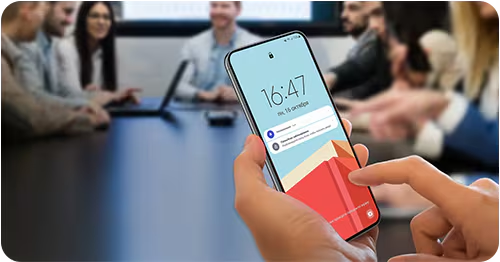How to use Interaction and Dexterity Enhancement Features on Your Galaxy Phone
If you're facing challenges related to mobility or coordination, there's no need to be concerned. Enhance the functionality of your phone screen through interaction and dexterity controls, enabling you to effortlessly engage with your apps, send text messages, and make calls. Connect external devices such as a mouse or keyboard for convenient navigation and fine-tune your screen's sensitivity to taps and touches. This way, you can avoid accidental selections and make the most of your device.

You can control the touch screen by connecting an external switch or by using head movements and face gestures.
- Open Settings and tap Accessibility > Interaction and dexterity > Universal switch.
- Read the on-screen instructions and tap Done.
- Tap the switch to turn it on.
- If the universal switches are not registered on the device, tap Add Switch and set switches to control the device.
Note:
- To turn on the universal switch feature, at least one switch must be registered on the device.
- To set switches to control the device, tap the switch under Switches.
- To turn off this feature, press the Side button and the Volume Up button simultaneously.
- Displaying the assistive shortcut icon
Set the device to display the assistive shortcut icon for accessing apps, features, and settings. You can control the device by tapping the assistive menus in the icon.
1. Open Settings and tap Accessibility > Interaction and Dexterity > Assistant menu.
2. Tap the switch to turn it on.
The assistive shortcut icon appears at the bottom right of the screen. To adjust the assistant shortcut icon’s transparency level, drag the adjustment bar under Transparency
- Accessing assistive menus
The assistive shortcut icon appears as a floating icon for access to the assistive menus from any screen. When you tap the assistive shortcut icon, the icon expands slightly and the assistive menus appear on the icon. Tap the left or right arrow, or swipe to the left or right, to select other menus.
- Using enhanced assistive menus
Set the device to display enhanced assistive menus for selected apps.
Open Settings, tap Accessibility > Interaction and dexterity > Assistant menu > Select apps to show contextual menus with, and then tap the switches next to the apps you want to turn on.
Use this feature to control your device by voice.
Open Settings, tap Accessibility > Interaction and Dexterity > Voice Access, and then tap the switch to turn it on.
Change the method for answering or ending calls.
Open Settings, tap Accessibility > Interaction and Dexterity > Answering and Ending Calls, and then tap the switch of the method you want.
Turn on the interaction control mode to restrict the device’s reaction to inputs while using apps.
- Open Settings and tap Accessibility > Interaction and Dexterity > Interaction Control.
- Tap the interaction control shortcut switch to turn it on.
- Press the Side button and the Volume Up button simultaneously while using an app.
- Adjust the size of the frame or draw a line around an area that you want to restrict.
- Tap Done.
The device displays the restricted area. The restricted area will not react when you touch it and the device’s buttons will be blocked. However, you can unblock functions for the Side button, volume button, and keyboard in interaction control mode.
Note:
- To turn off the interaction control mode, press the Side button and the Volume Up button simultaneously.
- To set the device to lock the screen after turning off the interaction control mode, open Settings, tap Accessibility > Interaction and dexterity > Interaction control, and then tap the Lock screen when deactivated switch to turn it on.
Set the recognition time for touching and holding the screen.
Open Settings, tap Accessibility > Interaction and Dexterity > Touch and hold delay, and then select an option.
Set the duration for which you must touch the screen for the device to recognize it as a tap.
Open Settings and tap Accessibility > Interaction and Dexterity > Tap duration, tap the switch to turn it on, and then set the time.
Set the device to recognize only the first tap within a set time when you tap the screen repeatedly.
Open Settings, tap Accessibility > Interaction and dexterity > Ignore repeated touches, tap the switch to turn it on, and then set the time.
Set the device to select an item automatically when you place the mouse pointer over the item. You can also assign actions to use when you move the pointer to a corner of the screen.
Open Settings, tap Accessibility > Interaction and Dexterity > Auto action after the pointer stops, and then tap the Auto-click switch to turn it on. To assign corner actions, select an option under Corner actions and select an action.
Set an external keyboard’s modifier key, such as the Shift, Ctrl, or Alt keys, to stay pressed. This helps you use keyboard shortcuts without pressing two keys at the same time.
Open Settings, tap Accessibility > Interaction and Dexterity, and then tap the Sticky Keys switch to turn it on.
Set the recognition time for pressing a key on the external keyboard.
Open Settings and tap Accessibility > Interaction and Dexterity > Slow keys, tap the switch to turn it on, and then set the time.
Set the device to recognize only the first time you press a key within a set time when you press the same key repeatedly.
Open Settings, tap Accessibility > Interaction and Dexterity > Bounce keys, tap the switch to turn it on, and then set the time.
Note: If you are still facing issues, you can call our contact center and our helpful agents will assist you.
Thank you for your feedback!
Please answer all questions.